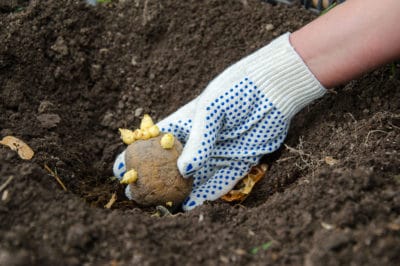Timing
Planting your potatoes at the wrong time can cut your crop short if the potatoes have too little time to mature or struggle in the heat. Although you can grow potatoes in any USDA zone, they are cool season vegetables. In the coldest climates, you must consider protection from late frosts, while desert gardeners should plant in winter to protect the plants from heat extremes.
Soil
The quality of your soil is one of the biggest factors in growing potatoes successfully. Potatoes need plenty of nutrients to produce their tubers. They prefer a slightly acidic soil with lots of humus to make it loose and friable. Good drainage is a must to prevent fungal infections and rot. A sandy loam is ideal, but you can amend the clay or sandy soil with aged manure, coarse builder’s sand, well-rotted leaves or organic compost and other amendments like kelp.
Spacing and Depth
Since potatoes are such heavy feeders, spacing is critical to ensure they don’t have too much competition for water and nutrients. In very rich soil, you can plant as close as 12 inches. If your soil is not as rich, space them 14 to 18 inches apart. You’ll need to hill them at least twice, so it makes sense to plant them initially about 12 inches below ground level and cover with four inches of soil.
Temperature
Temperatures have an effect all the way through the process of growing potatoes. For example:
- Once planted, potatoes will not begin to grow until the soil temperature reaches 45°F (7°C).
- Potatoes are usually sprouted (chitted) before planting; temperatures of 60 to 70°F (21 to16°C) are best.
- Potatoes grow and flower best at temperatures between 45 and 80°F (7 and 27°C).
Sprouting
While you can grow potatoes without sprouting them, sprouting offers some advantages. First, it ensures that every potato you plant has demonstrated it is capable of growing. This is particularly important if you have limited space or are trying an expensive new variety. Second, sprouting can give a head start on the season in cold climates – start your sprouts in a warm room a few weeks before planting time.
Size and Eyes
You can plant either small whole potatoes or cut pieces of larger potatoes. The cut up chunks should be about two or three inches in size. Cut potatoes should be cured – dried in a warm area for several days before planting. Make sure each potato or piece has at least two good eyes with healthy shoots – not all eyes will develop sprouts.
